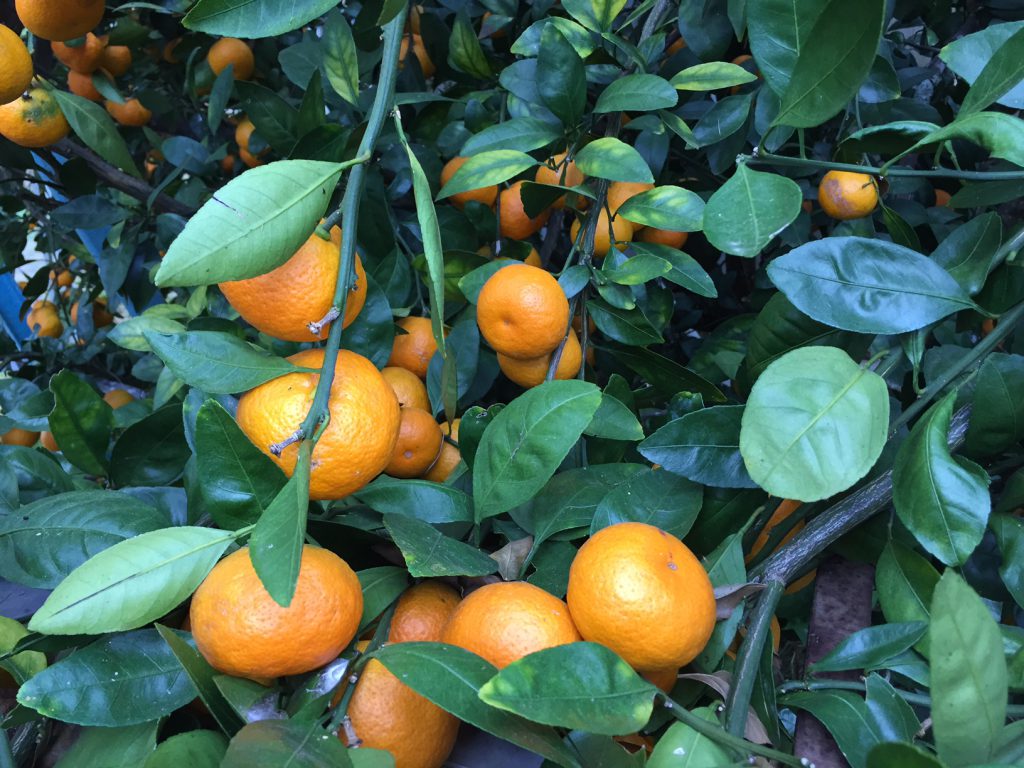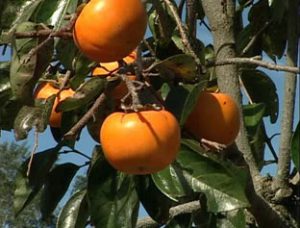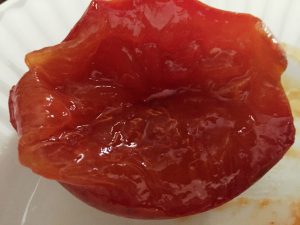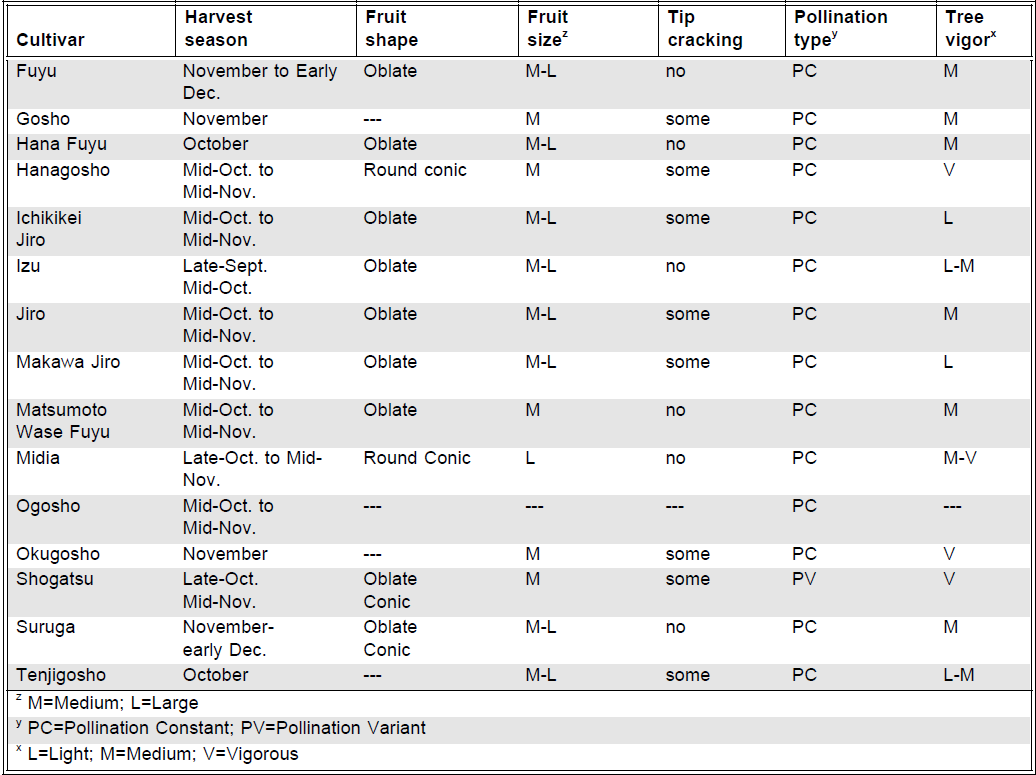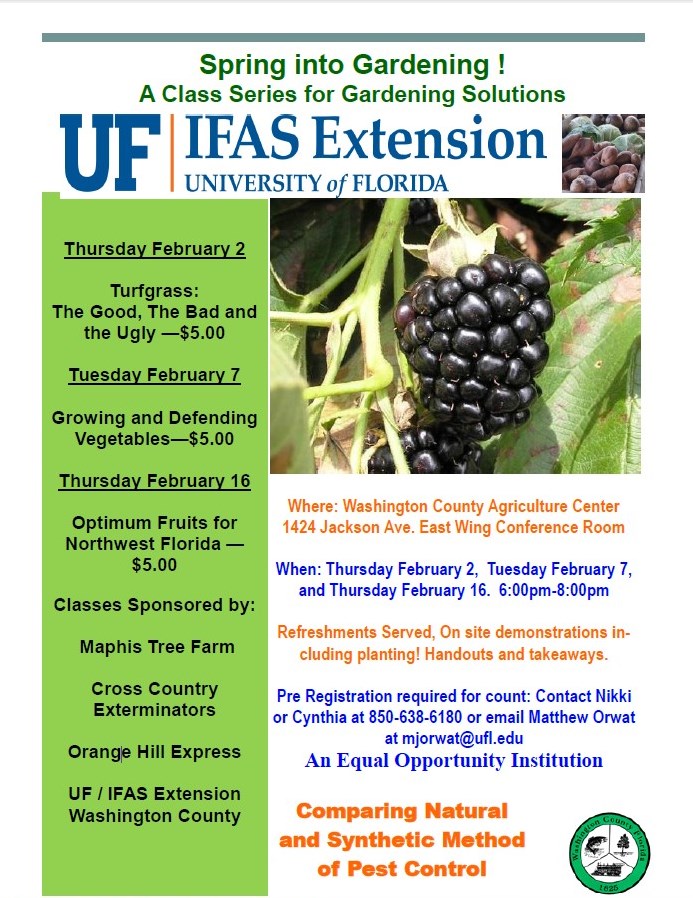

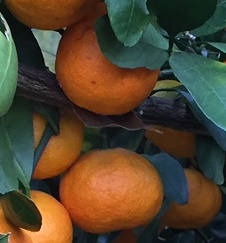
When is the Correct Time to Harvest Satsumas?
One question that repeatedly pops up in my Extension work is “When do I harvest fruit or vegetable X ?” This fall, the question of “when should I harvest my citrus?” has been a choice topic! The most common citrus in the Florida panhandle is the satsuma, Citrus unshiu, so it makes sense to limit this article to that species.
Harvesting satsumas can be a confusing activity for new citrus enthusiasts. Fall seasons in the panhandle tend to be extremely variable, from cold and wet to warm and dry or any combination thereof. To complicate matters, citrus is often grown in a protected microclimate in the garden. Thus, another variable is added to the decision tree.
Some harvest considerations to take note of:
- Sometimes the fruit is ready to harvest even when some green remains on the fruit
- Not all fruit on a given tree will be ready at the same time
- It’s a good idea to harvest a few fruit per tree and taste test….this will be a good indicator of the readiness of the other fruit on the tree
- A general trend to consider is that the longer the fruit remains on the tree, the sweeter it will become
When satsuma ripen, they become slightly soft. That’s a good indicator that they are ready to harvest. This softness makes them extremely easy to peel but poses a challenge when harvesting. If they are simply pulled off of the tree, some peel will be left on the tree and the fruit will be compromised. Such a fruit would have to be consumed quickly. To solve this problem satsuma are clipped off the tree, leaving a tiny bit of stem attached to the fruit. This allows the fruit to be stored and transported.
When a hard freeze is approaching (5 hours below 28ºF), it is important to harvest the fruit before this event whether or not they are ripe. Hard freezes will ruin the texture of the fruit and cause them to begin the rotting process.
Since a hard freeze is forecast for Friday December 9th 2016 for part of the Florida Panhandle, consult your local weather forecast and make your decisions accordingly. For an in-depth discussion on citrus fruit harvesting and cold tolerances, please consult this publication from Texas A& M University. Additional articles are available on cold protection and frost readiness here.

Persimmon: A Dooryard Fruit
A recent visit to the North Florida Research and Education Center reminded me of a fruit that is often low profile in Northwest Florida, the Oriental persimmon. The Oriental, or Japanese, persimmon (Diospyros kaki) was introduced to the Southern United States in the mid to late 1800s. Although it is native to Japan and China, it is a close relative of the native persimmon Diospyros virginiana.
In the early 20th century the oriental persimmon was a popular fruit crop in Florida, but this industry declined due to marketing factors. The Oriental persimmon is still a viable fruit for home gardens.
Trees are available grafted onto local native persimmon rootstock, which enhances their ability to perform well in Northwest Florida soils.
Persimmons are divided into two types for the purposes of marketing: astringent and non-astringent. Astringent persimmons contain high concentrations of tannins which cause the mouth to pucker when eating the persimmon if it is not fully ripe. When fully ripe, they are rich and sweet, but very soft. Non-astringent cultivars can be picked hard and ripened for 7-10 days at room temperature. Non-astringent persimmons were developed in Japan and introduced to the U.S. market in the 1980s. These have become very popular with home gardeners since they can be eaten when firm, and have a crunchy texture. Persimmons are popular today in Asian cuisine and as a dessert, since they contain sugars at levels between 15 and 25%.
Persimmons have relatively few pests in Northwest Florida when compared to other higher maintenance fruits such as peaches and plums. Fungal leaf spot caused by species of cercospora, alternaria and anthracnose can cause premature defoliation. Fungicidal sprays are useful in controlling these diseases if they are at high enough levels to cause tree injury. The stem and branch fungus Botrysphaeria dothidia will cause deep, elongated branch lesions similar to canker. These openings invite borers into the tree and can lead to loss of the limb structure. The best defense against this problem is a good offense; a healthy tree will be less likely to be attacked by this fungus. Dormant sprays of copper or sulfur based fungicides can also help reduce the incidence of all fungal diseases.
The major insect pest of persimmon is scale. Thankfully, scale can be controlled with dormant oil or season all horticultural oil. Persimmon psylla can cause leaf deformation early in the season, but is not always a large enough problem to warrant control. Natural enemies often eliminate the need for chemical control. If control is necessary, several insecticides labeled for fruit trees will take care of the problem. Twig girdlers can lay eggs on persimmon stems in September and October, and once hatched, the insect can girdle the stem and the stem will die. To control this pest it is important to remove dead and infected wood each growing season.
Out of the non-astringent cultivars, Fuyu regularly rates as the most popular and reliable cultivar. It does require thinning, since it often sets too much fruit, which can cause branches to bend and break. A good practice is to thin out 50% of the fruit during years in which fruit set is heavy.
Below is a chart of different non-astringent persimmon cultivar characteristics from the IFAS Extension publication SP 101, from April 1994 by E.P. Miller, Biologist; T.E. Crocker, Professor, Horticultural Sciences Department, Cooperative Extension Service, Institute of Food and Agricultural Sciences, University of Florida.
Characteristics of non-astringent cultivars. SP 101, from April 1994 by E.P. Miller; T.E. Crocker,
For further information please consult the UF / IFAS publication ENH 388: Diospyros kaki: Japanese Persimmon and the previous Panhandle Agriculture article Oriental Persimmon Varieties for North Florida .
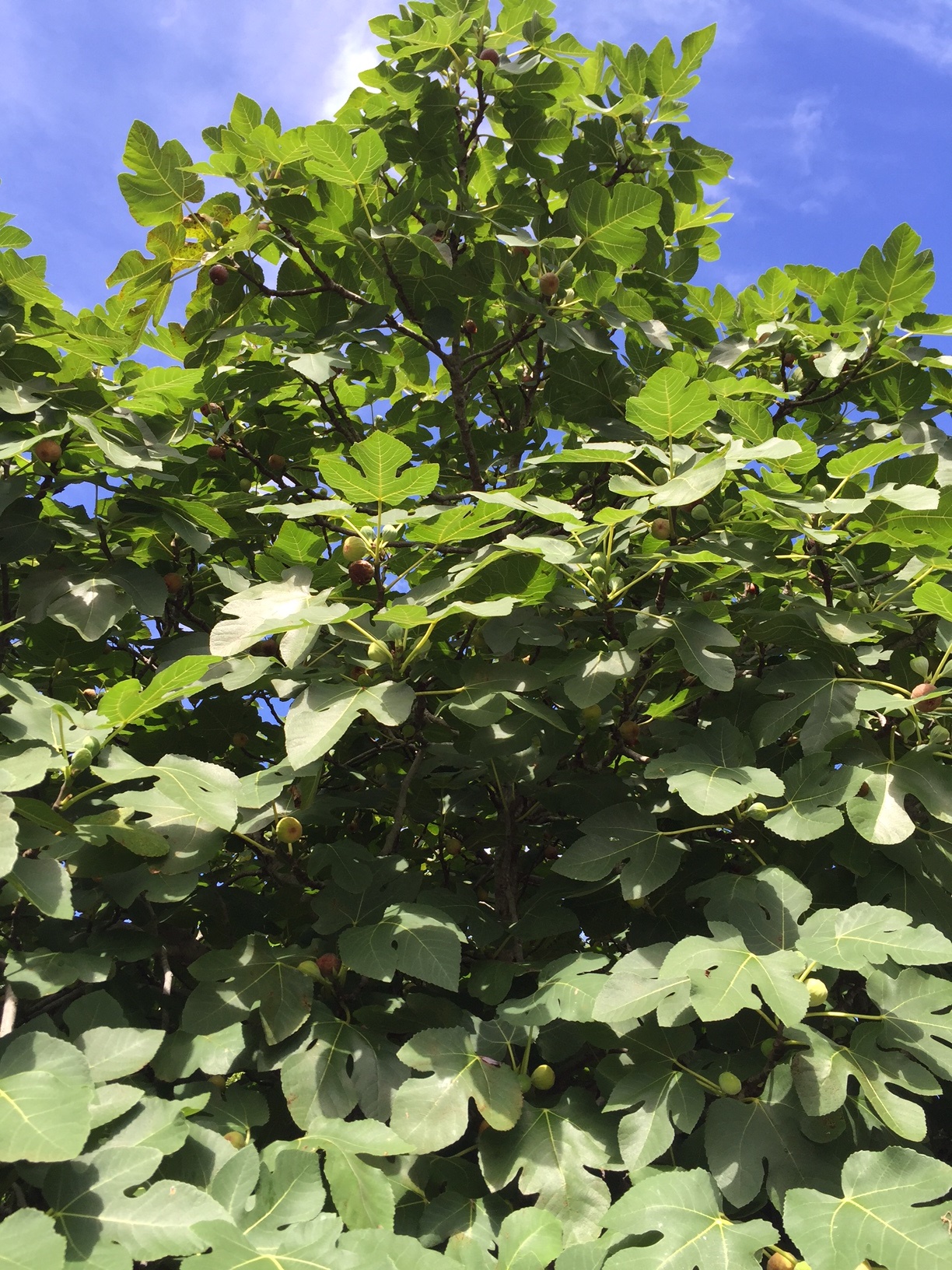
The Fig
Summer is full of simple pleasures—afternoon rainstorms, living in flip flops, and cooling off in a backyard pool. Among these, one of my favorites is walking out my door and picking handfuls of figs right from the tree. Before we planted our tree, my only prior experience with the fruit was a Fig Newton—I’d never eaten an actual fig, much less one picked fresh. Now, they are my favorite fruit.
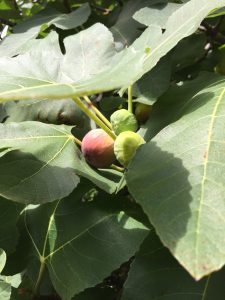
When ripe, figs are a deep shade of pink to purple. Larger green figs will ripen over the course of a few days. Photo credit: Carrie Stevenson
Native to Asia Minor and the Mediterranean, figs were introduced to Florida in the 1500’s by Spanish explorers. Spanish missionaries introduced these relatives of the mulberry to California a couple hundred years later. Figs are best suited to dry, Mediterranean-type climates, but do quite well in the southeast. Due to our humidity, southern-growing figs are typically fleshier and can split when heavy rains come through. The biggest threats to the health of the trees are insects, disease (also due to our more humid climate) and root-knot nematodes.
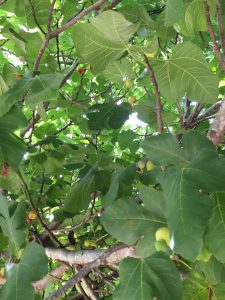
Fig trees can grow quite large and produce hundreds of fruit each year. Photo credit: Carrie Stevenson
Our tree started out just a couple of feet tall, but 12 years ago we replanted it along a fence in our back yard. It has grown so large (easily 25 feet tall and equally wide) that it hangs over our driveway, making it handy to grab a few as I hop in the car to run errands. The tree is in full sun at the bottom of a slope, and seems to be a satisfied recipient of all the runoff from our backyard. This position has resulted in a thick layer of soil and mulch in which it thrives.
We usually see small green fruit start to appear in early May, becoming fat and ripe by the second half of June. The tree produces steadily through early August, when the tree’s leaves turn crispy from the summer heat and there’s no more fruit to bear. The common fig doesn’t require a pollinator, so only one tree is necessary for production. The fiber-rich fig is also full of calcium, potassium, and vitamins A, E, and K. As it turns out, the “fruit” is actually a hollow peduncle (stem) that grows fleshy, forming a structure called a synconium. The synconium is full of unfertilized ovaries, making a fig a container that holds both tiny flowers and fruit in one.
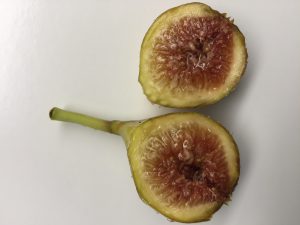
The insides of a fig show the small flowering structures that form the larger fruit. Photo credit: Carrie Stevenson
With the hundreds of figs we’ve picked, my family has made fig preserves, fig ice cream, baked figs and of course eaten them raw. We typically beg friends and neighbors to come help themselves—and bring a ladder—because we can’t keep up with the productivity. Often you can tell you’re near our tree from around the block, as the aroma of fermenting fruit baking on the driveway is far-reaching.
No matter what you do with them, I encourage planting these trees in your own yard to take full advantage of their sweet, healthy fruit and sprawling shade. As Bill Finch of the Mobile (AL) botanical gardens has written, “fresh…figs are fully enjoyed only by the family that grows them, and the very best figs are inevitably consumed by the person who picks them.”

The Forgotten Fruit and the Forgotten Coast
It’s safe to say that almost everyone equates citrus with the state of Florida. It just goes hand in hand. Most people first think of citrus as being oranges and grapefruit. Even by traveling south on I-75 or I-95, our welcome centers will gladly supply you with a complimentary cup of the juice of your choice, orange or grapefruit. However, the kumquat is a fruit that rarely comes to mind. The Panhandle is prime habitat for this forgotten fruit.
The kumquat is a native of southeast China, but it has found a home on the Gulf coast. It’s a cold hardy citrus, much like the Panhandle favorite satsuma orange. Due to the plants ability to be semi-dormant in the region, the kumquat has been known to withstand temperatures in the low teens. The kumquat fruit is an oddity in the citrus world. The peeling is sweet, the pulp is tart and it’s all edible, except for the seeds of course. The fruit reaches maturity around October, and will remain viable on the tree until March.
Figure 1: Kumquat fruit: Nagami variety.
Credit: UF/IFAS.
There are two varieties grown in Florida. The Nagami (Fortunella margarita) is by far the most popular in the state. This variety has oval shaped fruit and 2-5 seeds. The Meiwa (Fortunella crassifolia) has a more rounded shaped fruit with almost no seeds. This variety’s fruit is more sweet and juicy compared to the Nagami.
Kumquat is one of the easiest fruits to grow in the Panhandle. Most gardeners enjoy the ease of management as the kumquat tree is relatively small in size, and requires much less care compared to other citrus. Another advantage to kumquats is the ability to be grown in containers. Also, the dark green leaves and orange colored fruit is quite appealing on your back deck or patio.
When planting a kumquat, make sure the location has plenty of sunshine. Always apply mulch, but be sure to keep the mulch at least a foot from the trunk to combat any potential of disease. As for container growing, be sure to purchase a large container with adequate drainage holes. Place a screen in the bottom of the container, rather than rocks. This will ensure no soil is lost during drainage events. Newly planted kumquats will need significant water on a regular basis to become established, especially if planted in a container. Once established, watering can be limited.
Kumquats will need a fertilizer regimen too. A citrus formulated fertilizer works great. Although not required, pruning should be done after April or later in the summer before new flowers appear. A major plus, kumquat trees generally bear fruit just after a couple of years.
Kumquats are a delight to grow in the Panhandle and a fantastic evergreen for your landscape, back deck or patio.
Supporting information for this article can be found in the UF/IFAS EDIS publication, “Fortunella spp., Kumquat” by Michael G. Andreu, Melissa H. Friedman, and Robert J. Northrop & “Get Acquainted with Kumquat” by BJ Jarvis, CED & Horticultural Agent, UF/IFAS Pasco County Extension:
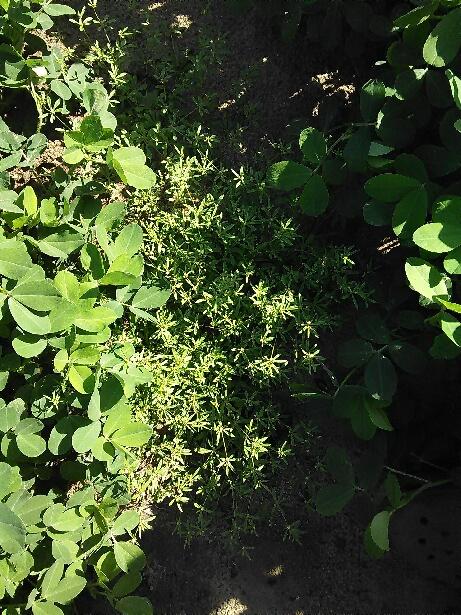
Do Your Plants have Problems?

When you don’t know what’s ailing your plant, ask an expert.
Many gardeners get stumped when a favorite plant of theirs comes down with a strange “something”. Many of these gardeners know about UF/IFAS Extension and call their local horticulture and agriculture agents for assistance in figuring out what’s going on. However, even these experts are often stumped by what they see. Fortunately, the agents have another layer of experts to fall back on. In addition to the resources in Gainesville, we have the Plant Disease Diagnostic Clinic, located at the North Florida Research Center in Quincy. Plant pathologists here can help determine what fungus, bacteria, virus, or viroid may be the problem.
Plant pathologists are basically plant doctors. They use all sorts of sophisticated techniques to determine what is the cause of a particular plant problem, from growing out fungal spores to examining DNA. Not only do these plant doctors tell us what the ailment is, they also provide recommended cures, or control options. They are also doing research to prevent different diseases from taking hold in our area and reduce the impact on our local growers.

Plant pathologist at work!
At a recent workshop in Quincy, we learned that plant pathology researchers are working on a fungus that affects watermelons, virus and bacteria that can wipe out a farmer’s tomato crop, and a virus that could impact our local roses. Working as a team of scientists, they study these pathogens in the lab and conduct controlled field experiments to figure out which techniques are most effective. Some of this research is leading to different methods and/or products that can help growers and gardeners alike keep their fields and landscapes healthy.
So, if your plants have problems, please contact your local Extension Office. If they don’t know the answer, then the network of scientists, including plant pathologists, in the UF/IFAS Extension family can be called on for backup to provide you with the best possible answer.

